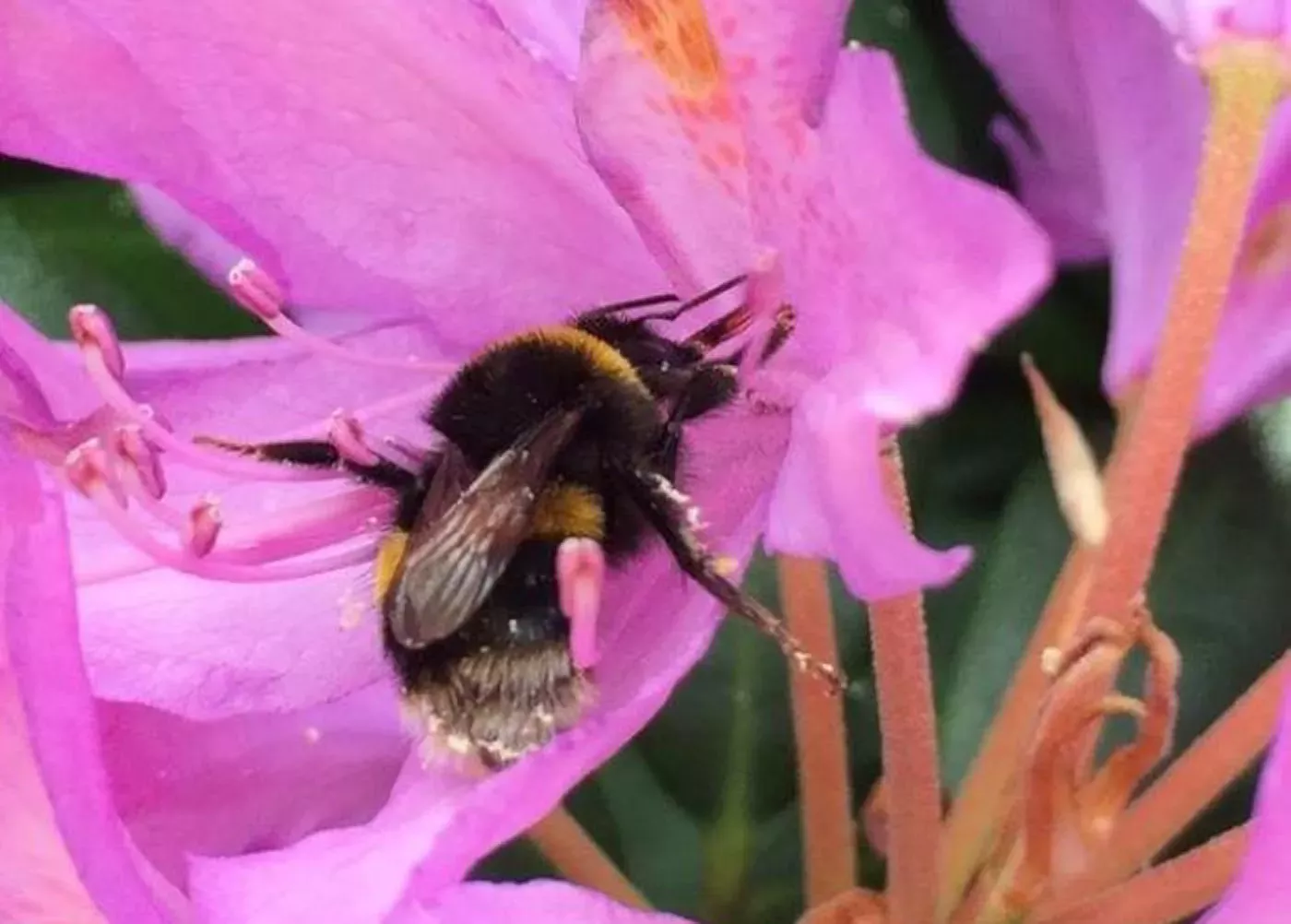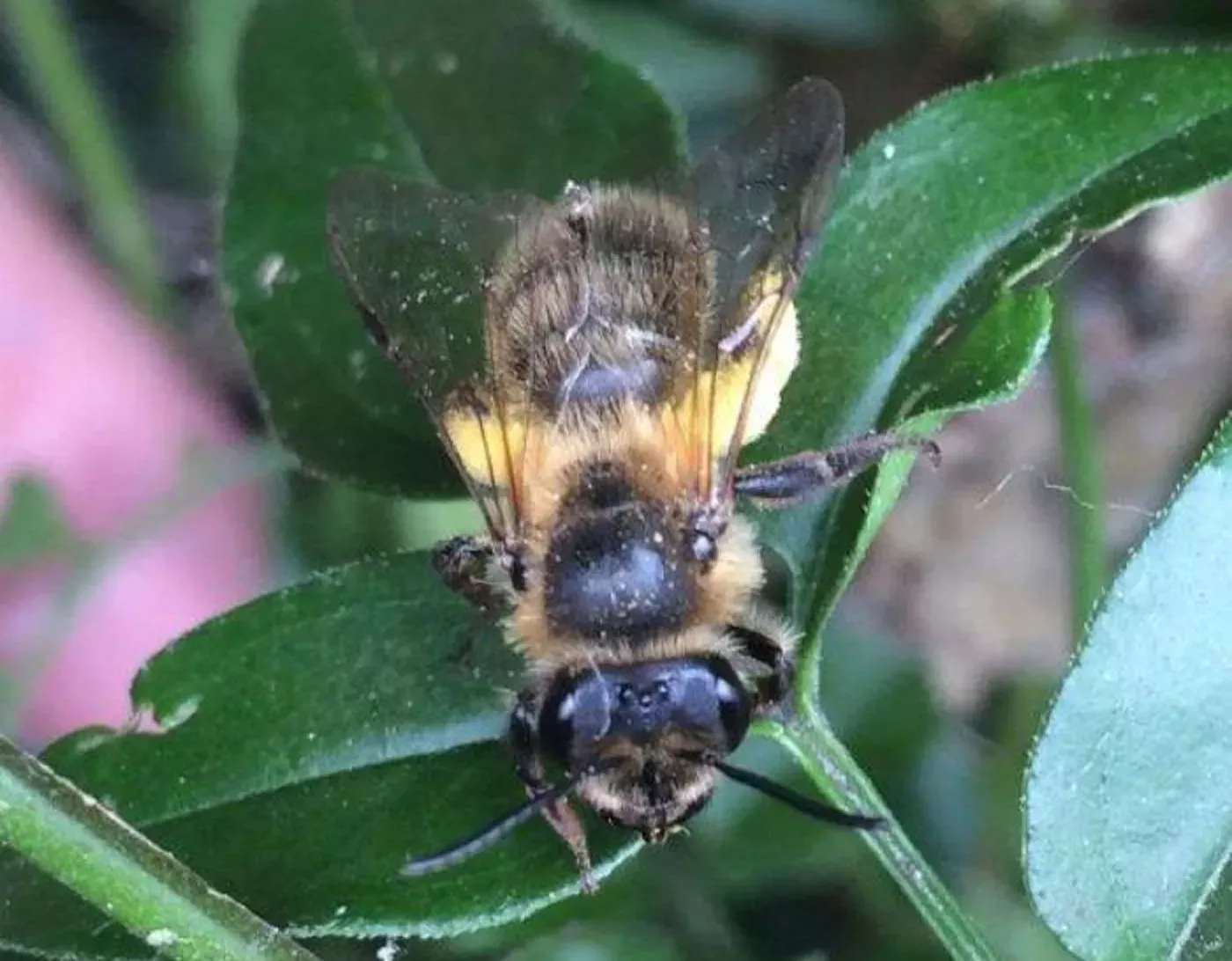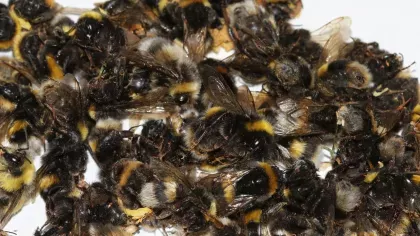15 March 2016
Hidden poisons in rhododendron nectar
Philip Stevenson (Plant Chemist) and Alison Scott-Brown (Plant/Insect Ecologist) from Kew’s Natural Capital and Plant Health department report on the toxicity of natural chemicals in the nectar and leaves of Rhododendron.

Rhododendrons are responsible for producing the world’s first recorded chemical weapons.
Several historical accounts from what is now modern Turkey cite the use of so-called 'mad honey' to stupefy naïve invading armies making them easier to attack.
'Mad honey' is the toxic honey produced by bees feeding on nectar of Rhododendron ponticum in its native northern Turkey.
Perhaps the most notable example was King Mithridates VI of Pontus: he was an early experimentalist with natural poisons, and placed the toxic honeycombs from the hives of honeybees that had been foraging on Rhododendron strategically along the roadside in advance of the invading army of Pompey the Great in 65BCE, as a trap.
The Roman garrison marching along the road sometime later stumbled upon this apparent gift from the gods and not recognising the danger, enthusiastically scoffed it, unwittingly poisoning themselves in the process.
While in their toxin induced stupor they were helplessly slaughtered by the army of Mithridates VI which was lying in wait.
Chemical defence in Rhododendron
The toxins responsible for the poisonous effects of Rhododendron are grayanotoxins.
These are highly oxygentated diterpenoids that have been presumed to be produced elsewhere in the plant as a natural chemical defence against insects.
Recent research in the laboratories at Kew has now shown, for the first time, that grayantoxins do indeed act as a natural defence for the plant and protect Rhododendron plants from herbivore attack.
Thrips are tiny winged insects which include some species that are pests of agricultural and horticultural crops around the world, damaging plants by sucking the life out of them.
One particular species, the glasshouse thrip (Heliothrips haemorrhoidalis), frequently causes damage to plants in the glasshouse collections at Kew.
It has been recorded feeding on the leaves of Rhododendron simsii, a species native to China, Taiwan and Burma, growing in Kew’s Temperate House.
Curiously, the thrips rarely damage the terminal 5–10 leaves which seem always to be left healthy and which are renewed each year.
These are the youngest leaves and are produced in a whorl each spring prior to flowering. Arguably these are the most critical leaf tissues so more important to protect.
Chemical analysis of these terminal leaves at Kew revealed they contained very high concentrations of grayanotoxins – the same compounds that poisoned Pompey’s army.
Biological studies testing the toxin which we isolated from the plants against the thrips showed that the grayanotoxins were indeed toxic to them, protecting these precious terminal leaves.
It’s interesting that the presence of the compounds seems to be only expressed locally in the plant tissue – perhaps to conserve energy and save just the most important new leaves each year.
Kew's recent study provides the first scientific evidence that the grayanotoxins are a natural defence mechanism against herbivores of Rhododendron.

Poisonous nectar
Many plants synthesise defence chemicals so it shouldn’t be a surprise that rhododendrons do as well.
What is puzzling though is why a plant would secrete insect defence toxins into nectar, as this is the food reward for pollinators which, in the case of Rhododendron, are insects and more specifically bees.
One might expect that this would be bad for the pollinators, or would repel them, but this isn’t always the case.
A previous collaboration between our lab at Kew and Prof. Jeri Wright at Newcastle University showed that the well-known plant chemical, caffeine, which like grayanotoxin is a defence chemical against insects for the coffee plant, also occurs in its floral nectar.
In this case, however, we found that the caffeine was present in nectar at concentrations too low for honeybees to taste but it still had a remarkable pharmacological effect on the bees.
It improved their memory for flower odours associated with food, making them more likely to return to and pollinate the plants providing caffeine as a reward.
So what might the effect of insect toxins in Rhododendron nectar be when encountered by bees?
In collaboration with Prof. Jane Stout at Trinity College, Dublin, we set about trying to find out. Earlier work had reported that the bumblebees such as Bombus terrestris pollinated Rhododendron so we investigated this bee species further.
Firstly, we had to isolate the toxin from the flowers using the analytical instrumentation in our laboratories at Kew.
We then had to confirm its chemical structure using and then determine how much of the chemical occurred in the nectar (in other words finding out how much the bees were consuming).
Despite the fact that Rhododendron honey was first reported as being toxic thousands of years ago, this was the first time the toxin had been identified and quantified in the nectar of the flowers from which the honey was made.
What do nectar toxins in Rhododendron do to bees?
The buff-tailed bumblebee (Bombus terrestris) was unable to detect the toxin at natural levels so it was certainly not repellent. Even after 30 days feeding on a nectar containing the toxin at natural levels, bumblebees were fine.
However, when the nectar was fed to honeybees they died in a matter of hours.
This was surprising as we know that in Turkey the local sub-species of Apis mellifera visited Rhododendron and made honey from it.
Testing the compounds against a third species, the mining bee, Andrena scotica (previousy A. carantonica) showed it was harmful to this species too.
Although it didn’t increase mortality in the mining bee, it severely affected their normal behaviours important for foraging such as time spent flying and increased time spent grooming, as well as showing other symptomatic behaviours associated with toxicity.

So why make nectar poisonous?
It’s possible that the toxin is an adaptation that allows the plant to filter out the less preferred bees and conserve the nectar reward for just bumblebee pollinators which can tolerate the toxin.
Bumblebees will spend more time feeding from Rhododendron flowers and therefore more likely transfer pollen from one flower to another of the same species.
So it's win win for Rhododendron and bumblebees. Specialisation is not uncommon in flower-pollinator interactions as a mechanism to optimise pollen transfer and we have written about this in an earlier blog about our work on Aconitum.
But rather like the Roman armies of yore that were poisoned by its toxins, Rhododendron is invasive in the British Isles.
Could our lovely bumblebees have unwittingly helped Rhododendron take over huge swathes of our natural landscapes?
As a very effective invasive, Rhododendron could be out-muscling native plant species and natural forage sources of other native bee species and honeybees.
If there is only room in the landscape for Rhododendron when they take over, then there is only room for bumblebees.
As much as we love bumblebees there has to be room for all the other wild species to ensure resilience and stability in our ecosystems.
The changing chemistry of invasive plants
But perhaps all is not lost.
We carried out a landscape scale chemical analysis of populations of Rhododendron ponticum in Ireland and compared this to the nectar toxin levels in its range in Spain and Portugal where the species is also native.
While the amounts of nectar toxins varied within the invasive and native ranges, expression was overall lower in the invasive range: in 1 out of 5 plants in the invasive range the toxins were absent from nectar altogether.
Other chemicals in the nectar which were not toxic to bees changed very little between the invasive and native ranges.
So in light of the specific change to the grayanotoxin, and its specific toxicity to some bee species, its expression may have been influenced during invasion by pollinator-mediated selection.
In other words, in the invasive range pollination was limited by the toxin so too few species were available for pollination. So the effect was for the plants to reduce or stop entirely the production of nectar toxins to ensure sufficient pollination success.
Synthesis
Rhododendrons produce toxins to protect against herbivores feeding on their leaves.
The toxins occur in nectar too where they ensure that only the best pollinators (that can tolerate the toxins) visit.
The toxin levels in nectar of invasive plants are lower than that of native plants.
So what does this mean for the defence of the plant?
If toxin levels in nectar and leaves are correlated with one another, we can assume that lower overall toxin levels in invasive plants might make them more exposed to herbivores.
Which function takes precedence for the plant: chemicals to optimise pollination or defence? Spatially explicit studies of nectar secondary compounds are needed to understand how chemical variation affects floral ecology.
Our understanding of plant invasion must consider plant defence not just in relation to protecting against herbivores but the consequences for beneficial interactions too.
References
Egan, P.A., Stevenson, P.C., Tiedeken E.J., Wright, G.A., Boylan, F. & Stout, J.C. (2016). Plant toxin levels in nectar vary spatially across native and introduced populations. Journal of Ecology Available online
Scott-Brown, A., Gregory, T., Farrell, I. & Stevenson, P.C. (2016). Leaf trichomes and grayanotoxin 1 mediate plant defence against glasshouse thrips in Rhododendron simsii. Functional Plant Biology(in review).
Stout, J.C. (2007a). Pollination of invasive Rhododendron ponticum (Ericaceae) in Ireland. Apidologie 38 ,1–9. Available online
Stout, J.C. (2007b). Reproductive biology of the invasive exotic shrub, Rhododendron ponticum L. (Ericaceae). Botanical Journal of the Linnean Society 155, 373–381. Available online
Tiedeken E.J., Stout J.C., Stevenson P.C. & Wright G.A. (2014). Bumblebees are not deterred by ecologically relevant concentrations of nectar toxins. Journal of Experimental Biology 217: 1620-1625. Available online
Tiedeken E.J., Egan, P.A., Stevenson, P.C., Wright, G.A., Brown, M.J.F., Power, E.F., Farrell., I., Matthews, S.M., Stout, J.C. (2015). Nectar chemistry modulates the impact of invasive plant species on native pollinators. Functional Ecology (online). Available online
Vanbergen A.J. & the Insect Pollinators Initiative. (2013).Threats to an ecosystem service: pressures on pollinators. Frontiers in Ecology and the Environment 11: 251-259. Available online
Wright G.A., Baker D.D., Palmer M.J., Stabler D., Mustard J.A., Power E.F., Borland A.M. & Stevenson P.C. (2013). Caffeine in floral nectar enhances a pollinator’s memory of reward. Science 339: 1202-1204. Available online


_0.jpg.webp?itok=ySwNK0jk)
